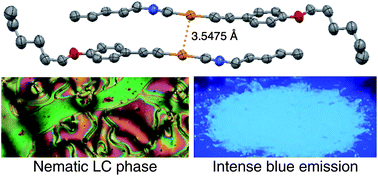Novel liquid crystalline (LC) gold(I) complexes were synthesised and their LC behaviour and photophysical properties were investigated. Simple ligands were utilised in order to prevent steric hindrance and facilitate a strong intermolecular aurophilic interaction, resulting in highly efficient photoluminescence. It was found that the complexes easily formed dimers in the crystalline, LC, and isotropic phases due to strong interaction between the gold atoms of neighbouring molecules, and that these dimers acted as unit mesogens in the LC phase. The complexes exhibited intense blue photoluminescence with quantum yields of 8–50% in the condensed phases, but no photoluminescence in dilute solutions. It was therefore concluded that the luminescence was due to the dimers, and that the formation of these was facilitated by the simplicity of the ligands surrounding the gold atoms, resulting in a low level of steric hindrance and strong aurophilic interaction.

